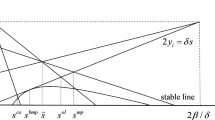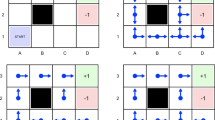Abstract
We consider two models for stochastic equilibrium: one based on the variational equilibrium of a generalized Nash game, and the other on the mixed complementarity formulation. Each agent in the market solves a single-stage risk-averse optimization problem with both here-and-now (investment) variables and (production) wait-and-see variables. A shared constraint couples almost surely the wait-and-see decisions of all the agents. An important characteristic of our approach is that the agents hedge risk in the objective functions (on costs or profits) of their optimization problems, which has a clear economic interpretation. This feature is obviously desirable, but in the risk-averse case it leads to variational inequalities with set-valued operators—a class of problems for which no established software is currently available. To overcome this difficulty, we define a sequence of approximating differentiable variational inequalities based on smoothing the nonsmooth risk measure in the agents’ problems, such as average or conditional value-at-risk. The smoothed variational inequalities can be tackled by the PATH solver, for example. The approximation scheme is shown to converge, including the case when smoothed problems are solved approximately. An interesting by-product of our proposal is that the smoothing approach allows us to show existence of an equilibrium for the original problem. To assess the proposed technique, numerical results are presented. The first set of experiments is on randomly generated equilibrium problems, for which we compare the proposed methodology with the standard smooth reformulation of average value-at-risk minimization (using additional variables to rewrite the associated max-function). The second set of experiments deals with a part of the real-life European gas network, for which Dantzig–Wolfe decomposition can be combined with the smoothing approach.






Similar content being viewed by others
References
Baldick, R., Helman, U., Hobbs, B., O’Neill, R.: Design of efficient generation markets. Proc. IEEE 93(11), 1998–2012 (2005). doi:10.1109/JPROC.2005.857484
Burke, J., Hoheisel, T.: Epi-convergent smoothing with applications to convex composite functions. SIAM J. Optim. 23, 1457–1479 (2013)
Chen, C., Mangasarian, O.: A class of smoothing functions for nonlinear and mixed complementarity problems. Comput. Optim. Appl. 5, 97–138 (1996)
Chen, X.: Smoothing methods for nonsmooth, novonvex minimization. Math. Program. 134, 71–99 (2012)
Chen, X., Fukushima, M.: Expected residual minimization method for stochastic linear complementarity problems. Math. Oper. Res. 30(4), 1022–1038 (2005). doi:10.1287/moor.1050.0160
Chen, X., Wets, R.J.B., Zhang, Y.: Stochastic variational inequalities: residual minimization smoothing sample average approximations. SIAM J. Optim. 22(2), 649–673 (2012)
Chen, X., Zhang, C., Fukushima, M.: Robust solution of monotone stochastic linear complementarity problems. Math. Program. 117(1–2), 51–80 (2009). doi:10.1007/s10107-007-0163-z
Collado, R.A., Powell, W.B.: Threshold risk measures part 1: finite horizon http://castlelab.princeton.edu/Papers/Collado-Threshold-Measures-FINITE_ONLY-April-22-2013.pdf (2013)
Conejo, A., Nogales, F., Arroyo, J., Garcia-Bertrand, R.: Risk-constrained self-scheduling of a thermal power producer. IEEE Trans. Power Syst. 19(3), 1569–1574 (2004). doi:10.1109/TPWRS.2004.831652
Conejo, A.J., Carrión, M., Morales, J.M.: Decision Making Under Uncertainty in Electricity Markets. International Series in Operations Research & Management Science. Springer, New York (2010)
David, A., Wen, F.: Strategic bidding in competitive electricity markets: a literature survey. In: Power Engineering Society Summer Meeting, 2000. IEEE, vol. 4, pp. 2168–2173 (2000). doi:10.1109/PESS.2000.866982
Dentcheva, D., Ruszczyński, A., Shapiro, A.: Lectures on Stochastic Programming. SIAM, Philadelphia (2009)
Dirkse, S., Ferris, M.: The PATH solver : a nonmonotone stabilization scheme for mixed complementarity problems. Optim. Methods Softw. 5, 123–156 (1995)
Egging, R.: Benders decomposition for multi-stage stochastic mixed complementarity problems applied to a global natural gas market model. Eur. J. Oper. Res. 226(2), 341–353 (2013). doi:10.1016/j.ejor.2012.11.024
Egging, R.G., Gabriel, S.A.: Examining market power in the European natural gas market. Energy Policy 34(17), 2762–2778 (2006). doi:10.1016/j.enpol.2005.04.018
Ehrenmann, A., Neuhoff, K.: A comparison of electricity market designs in networks. Oper. Res. 57(2), 274–286 (2009)
Ehrenmann, A., Smeers, Y.: Generation capacity expansion in risky environment: a stochastic equilibrium analysis. Oper. Res. 59(6), 1332–1346 (2011)
Facchinei, F., Fischer, A., Piccialli, V.: On generalized Nash games and variational inequalities. Oper. Res. Lett. 35, 159–164 (2007)
Facchinei, F., Kanzow, C.: Generalized nash equilibrium problems. Ann. OR 175(1), 177–211 (2010)
Facchinei, F., Pang, J.S.: Finite-Dimensional Variational Inequalities and Complementarity Problems. Springer Series in Operations Research, vol. II. Springer, New York (2003)
Ferris, M.C., Munson, T.S.: Interfaces to PATH 3.0: design, implementation and usage. Comput. Optim. Appl. 12, 207–227 (1999)
Fuller, J.D., Chung, W.: Dantzig–Wolfe decomposition of variational inequalities. Comput. Econ. 25, 303–326 (2005). doi:10.1007/s10614-005-2519-x
Gabriel, S.A., Zhuang, J., Egging, R.: Solving stochastic complementarity problems in energy market modeling using scenario reduction. Eur. J. Oper. Res. 197(3), 1028–1040 (2009). doi:10.1016/j.ejor.2007.12.046
Hiriart-Urruty, J.B., Lemaréchal, C.: Convex Analysis and Minimization Algorithms. No. 305–306 in Grund. der math. Wiss. Springer, Berlin (1993). (two volumes)
Hobbs, B., Metzler, C., Pang, J.S.: Strategic gaming analysis for electric power systems: an MPEC approach. IEEE Trans. Power Syst. 15(2), 638–645 (2000). doi:10.1109/59.867153
Hu, X., Ralph, D.: Using EPECs to model bilevel games in restructured electricity markets with locational prices. Oper. Res. 55(5), 809–827 (2007)
Kannan, A., Shanbhag, U.V., Kim, H.M.: Addressing supply-side risk in uncertain power markets: stochastic nash models, scalable algorithms and error analysis. Optim. Methods Softw. 28(5), 1095–1138 (2013). doi:10.1080/10556788.2012.676756
Kulkarni, A., Shanbhag, U.: On the variational equilibrium as a refinement of the generalized Nash equilibrium. Automatica 48, 45–55 (2012)
Kulkarni, A.A., Shanbhag, U.V.: Revisiting generalized Nash games and variational inequalities. J. Optim. Theory Appl. 154, 175–186 (2012)
Lin, G.H., Chen, X., Fukushima, M.: Solving stochastic mathematical programs with equilibrium constraints via approximation and smoothing implicit programming with penalization. Math. Program. 116(1–2), 343–368 (2009)
Luna, J.P., Sagastizábal, C., Solodov, M.: A class of Dantzig–Wolfe type decomposition methods for variational inequality problems. Math. Program. 143, 177–209 (2014). doi:10.1007/s10107-012-0599-7
Luna, J.P., Sagastizábal, C., Solodov, M.: Complementarity and game-theoretical models for equilibria in energy markets: deterministic and risk-averse formulations. In: Kovacevic, R., Pflug, G., Vespucci, M. (eds.) International Series in Operations Research and Management Science, vol. 199, Chap. 10, pp. 237–264. Springer, Berlin (2014)
Meng, F., Sun, J., Goh, M.: A smoothing sample average approximation method for stochastic optimization problems with CVaR risk measure. Comput. Optim. Appl. 50(2), 379–401 (2011)
Pang, J.S.: Three modeling paradigms in mathematical programming. Math. Program. 125(2), 297–323 (2010). doi:10.1007/s10107-010-0395-1
Pang, J.S., Fukushima, M.: Quasi-variational inequalities, generalized Nash equilibria, and multi-leader-follower games. Comput. Manag. Sci. 2(1), 21–56 (2005). doi:10.1007/s10287-004-0010-0
Pang, J.S., Fukushima, M.: Quasi-variational inequalities, generalized Nash equilibria, and multi-leader-follower games. Comput. Manag. Sci. 6(3), 373–375 (2009). doi:10.1007/s10287-009-0093-8
Patriksson, M., Wynter, L.: Stochastic mathematical programs with equilibrium constraints. Oper. Res. Lett. 25(4), 159–167 (1999). doi:10.1016/S0167-6377(99)00052-8
Ralph, D., Smeers, Y.: EPECs as models for electricity markets. In: Power Systems Conference and Exposition, 2006. PSCE ’06. 2006 IEEE PES, pp. 74–80 (2006). doi:10.1109/PSCE.2006.296252
Ralph, D., Smeers, Y.: Pricing risk under risk measures: an introduction to stochastic-endogenous equilibria. Social Sci. Res. Netw. http://ssrn.com/abstract=1903897 (2011)
Ralph, D., Xu, H.: Implicit smoothing and its application to optimization with piecewise smooth equality constraints1. J. Optim. Theory Appl. 124(3), 673–699 (2005)
Ravat, U., Shanbhag, U.V.: On the characterization of solution sets of smooth and nonsmooth convex stochastic Nash games. SIAM J. Optim. 21(3), 1168–1199 (2011)
Rockafellar, R., Uryasev, S.: Conditional value-at-risk for general loss distributions. J. Bank. Finance 26(7), 1443–1471 (2002)
Rockafellar, R., Wets, J.B.: Variational Analysis. Springer, New York (1997)
Shapiro, A., Xu, H.: Stochastic mathematical programs with equilibrium constraints. J. Optim. Theory Appl. 128(1), 223243 (2006). doi:10.1007/s10957-005-7566-x
Wets, R.J.B.: Stochastic programming models: wait-and-see versus here-and-now. In: Greengard, C., Ruszczynski, A. (eds.) Decision Making Under Uncertainty, The IMA Volumes in Mathematics and Its Applications, vol. 128, pp. 1–15. Springer, New York (2002). doi:10.1007/978-1-4684-9256-9_1
Xu, H., Zhang, D.: Smooth sample average approximation of stationary points in nonsmooth stochastic optimization and applications. Math. Program. 119(2), 371–401 (2009)
Xu, H., Zhang, D.: Stochastic Nash equilibrium problems: sample average approximation and applications. Comput. Optim. Appl. 55(3), 597–645 (2013)
Yin, H., Shanbhag, U., Mehta, P.: Nash equilibrium problems with scaled congestion costs and shared constraints. IEEE Trans. Autom. Control 56(7), 1702–1708 (2011). doi:10.1109/TAC.2011.2137590
Zhao, J., Hobbs, B.F., Pang, J.S.: Long-run equilibrium modeling of emissions allowance allocation systems in electric power markets. Oper. Res. 58(3), 529–548 (2010)
Acknowledgments
The authors acknowledge insightful and significant comments and remarks from the reviewers and the editors, which led to a substantially improved version of this work. The authors also thank Alexey Izmailov on the issue of computing the second derivatives described in Proposition 2.
Author information
Authors and Affiliations
Corresponding author
Additional information
Juan Pablo Luna was supported by CNPq post-doctoral scholarship 503441/2012-0. Claudia Sagastizábal is partially supported by Grants CNPq 303840/2011-0, AFOSR FA9950-11-1-0139, as well as by PRONEX-Optimization and FAPERJ. Mikhail Solodov is supported in part by CNPq Grants 302637/2011-7 and PVE 401119/2014-9, by PRONEX-Optimization and by FAPERJ.
Rights and permissions
About this article
Cite this article
Luna, J.P., Sagastizábal, C. & Solodov, M. An approximation scheme for a class of risk-averse stochastic equilibrium problems. Math. Program. 157, 451–481 (2016). https://doi.org/10.1007/s10107-016-0988-4
Received:
Accepted:
Published:
Issue Date:
DOI: https://doi.org/10.1007/s10107-016-0988-4
Keywords
- Stochastic equilibrium
- Risk aversion
- Generalized Nash game
- Variational inequality
- Complementarity
- Dantzig–Wolfe decomposition




